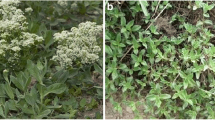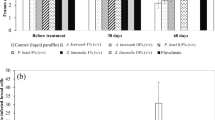Abstract
Varroa destructor is an ectoparasitic mite that affects colonies of honey bee Apis mellifera worldwide. In the last years, substances of botanical origin have emerged as natural alternative acaricides to diminish the population levels of the mite. In the present work, the bioactivity of propolis from different geographical locations of Pampean region from Argentina on V. destructor was evaluated. Fourteen propolis samples were organoleptic and physicochemically characterized and, by means topical applications, their activity was tested on mites. All propolis had a homogeneous composition and the bioactivity levels against mites were comparable among the different propolis samples. The percentage of mites killed by the treatments ranged between 60.5% and 90% after 30 s of exposure. Thus, V. destructor was highly susceptible to propolis. Moreover, the mites remained anesthetized during the first hours after topical treatment. The results suggest that propolis from Argentinean pampas could be incorporated in honey bee colonies as acaricidal treatment by spraying.
Similar content being viewed by others
References
Anderson D, Trueman J (2000) Varroa jacobsoni (Acari: Varroidae) is more than one species. Exp Appl Acarol 24:165–189. doi:10.1023/A:1006456720416
Antúnez K, Harriet J, Gende L, Maggi M, Eguaras M, Zunino P (2008) Efficacy of natural propolis extract in the control of American Foulbrood. Vet Microbiol 131:324–331. doi:10.1016/j.vetmic.2008.04.011
Bankova V (2005) Recent trends and important developments in propolis research. eCAM 2(1):29–32, 10.1093/ecam/neh059
Bankova VS, Popov SS, Marekov NL (1983) A study on flavonoids of propolis. J Nat Prod 46(4):471–474. doi:10.1021/np50028a007
Bankova V, Marcucci MC, Simova S, Nikolova N, Kujumgiev A, Popov S (1996) Antibacterial diterpenic acids from Brazilian propolis. Z Naturforsch C 51(5–6):277–280
Bankova VS, De Castro SL, Marcucci MC (2000) Propolis: recent advances in chemistry and plant origin. Apidologie 31:3–15. doi:10.1051/apido:2000102
Banskota HA, Tezuka Y, Kadota S (2001) Recent progress in pharmacological research of propolis. Phytother Res 15(7):561–571. doi:10.1002/ptr.1029
Bedascarrasbure E, Maldonado L, Fierro Morales W, Álvarez A (2006) Propóleos. Caracterización y normalización de propóleos argentinos. Revisión y actualización de composición y propiedades. Ediciones Magna Publicaciones, Tucumán
Bogdanov S, Kolchenmann V, Imdorf A (1998) Acaricide residues in some bee products. J Apic Res 37:57–67
Bonvehi JS, Coll FV (1994) Phenolic composition of propolis from China and from South America. Z Naturforsch C 49:712–718
Burdock GA (1998) Review of the biological properties and toxicity of bee propolis (Propolis). Food Chem Toxicol 36:347–363. doi:10.1016/S0278-6915(97)00145-2
Cunha IBS, Sawaya ACHF, Caetano FM, Shimizu MT, Marcucci MC, Drezza FT, Povia GS, Carvalho PO (2004) Factors that influence the yield and composition of Brazilian propolis extracts. J Braz Chem Soc 15(6):964–970. doi:10.1590/S0103-50532004000600026
Damiani N, Gende L, Bailac P, Marcangeli J, Eguaras M (2009) Acaricidal and insecticidal activity of essential oils on Varroa destructor (Acari: Varroidae) and Apis mellifera (Hymenoptera: Apidae). Parasitol Res 106(1):145–152. doi:10.1007/s00436-009-1639-y
Dellacasa AD, Bailac PN, Ponzi MI, Ruffinengo SR, Eguaras MJ (2003) In vitro activity of essential oils against Ascosphaera apis. J Essent Oil Res 15(3):282–285
Freitas SF, Shinohara L, Sforcin JM, Guimarães S (2006) In vitro effects of propolis on Giardia duodenalis trophozoites. Phytomed 13:170–175. doi:10.1016/j.phymed.2004.07.008
Garedew A, Lamprecht I, Schmolz E, Schricker B (2002) The varroacidal action of propolis: a laboratory assay. Apidologie 33:41–50. doi:10.1051/apido:2001006
Garedew A, Schmolz E, Lamprecht I (2004) Effect of the bee glue (propolis) on the calorimetrically measured metabolic rate and metamorphosis of the greater wax moth Galleria mellonella. Thermochem Acta 413:63–72. doi:10.1016/j.tca.2003.10.014
Gende LB, Palazzetti M, Pannone O, Fritz R, Eguaras MJ, Saccares S, Dell’Aira E, Formato G (2007) Comparative field trials of Paenibacillus larvae control with antibiotics, essential oil of cinnamon and propolis. Proceedings of 40th Apimondia Congress
Gende LB, Maggi M, Damiani N, Fritz R, Eguaras MJ, Floris I (2009) Advances in the apiary control of the honeybee American foulbrood with Cinnamon (Cinnamomun zeylanicum) essential oil. B Insectol 62(1):93–97
Harish Z, Rubinstein A, Golodner M, Elmaliah M, Mizrachi Y (1997) Suppression of HIV-1 replication by propolis and its immunoregulatory effect. Drugs Exp Clin Res 23(2):89–96
Higashi KO, De Castro SL (1994) Propolis extracts are effective against Trypanosoma cruzi and have an impact on its interaction with host cells. J Ethnopharmacol 43:149–155. doi:10.1016/0378-8741(94)90012-4
Huleihel M, Isanu V (2002) Anti-herpes simplex virus effect of an aqueous extract of propolis. Isr Med Assoc J 4(11 Suppl):923–927
IRAM-INTA Norms 15935-1 (2008) NOA (Argentinean northwest) products. Propolis. Part 1: Propolis in natura. pp 25
Johnson KS, Eischen FA, Giannasi DE (1994) Chemical composition of North American bee propolis and biological activity towards larvae of greater wax moth (Lepidoptera: Pyralidae). J Chem Ecol 20(7):1783–1791. doi:10.1007/BF02059899
Maggi M, Ruffinengo S, Damiani N, Sardella N, Eguaras E (2009) First detection of Varroa destructor resistance to coumaphos in Argentina. Exp Appl Acarol 47(4):317–320. doi:10.1007/s10493-008-9216-0
Marcucci MC (1995) Propolis: chemical composition, biological properties and therapeutic activity. Apidologie 26:83–99. doi:10.1051/apido:19950202
Medana C, Carbone F, Aigotti R, Appendino G, Baiocchi C (2008) Selective analysis of phenolic compounds in propolis by HPLC-MS/MS. Phytochem Anal 19(1):32–39. doi:10.1002/pca.1010
Milani N (1995) The resistance of Varroa jacobsoni Oud to pyrethroids: a laboratory assay. Apidologie 26:415–429. doi:10.1051/apido:19950507
Milani N (1999) The resistance of Varroa jacobsoni Oud. to acaricides. Apidologie 30:229–234. doi:10.1051/apido:19990211
Oršolić N, Šaranović AB, Bašić I (2006) Direct and indirect mechanism(s) of antitumour activity of propolis and its polyphenolic compounds. Planta Med 72:20–27
Park YK, Koo MH, Abreu JAS, Ikegaki M, Cury JA, Rosalen PL (1998) Antimicrobial activity of propolis on oral microorganisms. Curr Microbiol 36:24–28. doi:10.1007/s002849900274
Pohorecka K (2004) Laboratory studies on the effect of standardized Artemisia absinthium L. extract on Nosema apis infection in the worker Apis mellifera. J Apicult Sci 48(2):131–136
Topalkara A, Vural A, Polat Z, Toker MI, Arici MK, Ozan F, Cetin A (2007) In vitro amoebicidal activity of propolis on Acanthamoeba castellanii. J Ocul Pharmacol Ther 23(1):40–45. doi:10.1089/jop.2006.0053
Wallner K (1999) Varroacides and their residues in bee products. Apidologie 30:235–248. doi:10.1051/apido:19990212
Acknowledgements
We would to thank to all beekeepers that contributed to the propolis samples collections and the media involved in the called diffusion, Javier Folgar, Federico Petrera and their team. To Tec. Carlos Torne for the help in the physicochemical analyses of propolis samples in INTA Famailla, Tucumán. This study was support by PICT REDES Project Nº 00890 to ME (ANPCYT) and Exa Project Nº 376/07 to JM (UNMDP), Argentina.
Author information
Authors and Affiliations
Corresponding author
Rights and permissions
About this article
Cite this article
Damiani, N., Fernández, N.J., Maldonado, L.M. et al. Bioactivity of propolis from different geographical origins on Varroa destructor (Acari: Varroidae). Parasitol Res 107, 31–37 (2010). https://doi.org/10.1007/s00436-010-1829-7
Received:
Accepted:
Published:
Issue Date:
DOI: https://doi.org/10.1007/s00436-010-1829-7




